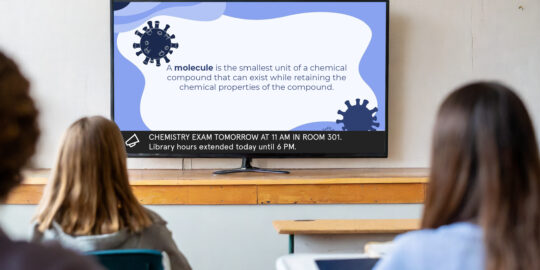A fortuitous conversation during a social tennis match between Vivi founder Dr. Lior Rauchberger and security expert Craig Harwood was the moment of inspiration for a powerful, and potentially lifesaving, feature in Vivi’s Wireless Presentation System – the Emergency Broadcast functionality. Harwood remembers it as a classic lightbulb moment.
“Lior and I were discussing the Vivi technology, and I had an immediate idea to use it for emergency management broadcasting.”
Harwood’s insight into emergency management was no coincidence. After a highly decorated career in Special Operations and Anti-Terrorism within Victoria Police, he founded and ran SECUREcorp, a company that provides security services to everything from major events and large shopping centers to defense sites, universities and schools. As a result, he was very familiar with the common challenges faced in emergency situations, whether they be natural disasters, environmental threats such as building fires, or when individuals are looking to cause harm. In Vivi, he saw a potential solution.
The difficulties in responding to an emergency
The key to minimizing harm in a large-scale emergency is to achieve “situational awareness” as quickly as possible. That is, for the people who are at risk to understand that risk, and then either shelter in place or evacuate. But in the midst of an emergency situation, this doesn’t often happen. “People at the epicenter, who are most affected by the event, can react to the threat, but may still be confused. And in an education setting where there are multiple buildings, students and staff may be unaware of what’s going on, but still at risk,” Harwood explains. “The core issue is one of notification. Unfortunately, information tends to flow out from the epicenter too slowly for some people to take appropriate action.”
For this information flow to start, a person close to the incident has to be able to phone the school’s front desk to activate the emergency management plan. But depending on the nature of the emergency, using a phone isn’t always possible. And if the front desk has been affected by the emergency, there’s no-one there to receive the information anyway. In a scenario where avoiding harm is, in Harwood’s words, “always a time and space issue,” these impediments to achieving situational awareness leave people exposed to danger for longer periods.
How Vivi can help to avert disaster
Harwood’s lightbulb moment was seeing a school’s network of Vivi-connected devices and displays as a ready-made pathway for immediate notification in an emergency. Authorized teachers can activate the feature by tapping the emergency icon at the top-right of their screen, choosing between “lockdown” or “evacuation”, and then tapping a final time to confirm the activation. Instantly, every screen and device with an active Vivi connection will display the lockdown or evacuation message and indicate where in the school the feature was initiated from. The messaging can also be customized to display evacuation plans and other instructions. Additional notifications are emailed to wardens so they can enact the school’s emergency management plan and communicate with first responders.
.png)
All of this happens as soon as the feature is activated, delivering instantaneous, saturation-level situational awareness. The emergency notification can be retracted just as quickly, alerting the school community that there is no longer a threat to safety.
The feature is intentionally very simple. “When you’re under stress, you’ve got gross motor functions happening, you’ve got the adrenaline running through you. The feature needed to be simple to use – three touches, and it’s done,” says Harwood. “The iconography we’ve used is simple and intuitive. We spent a lot of time making sure it could be understood immediately, globally.”
As a result, Vivi’s Emergency Broadcast feature will have a very real impact wherever the feature is used. “Obviously we don’t want the feature to be needed,” says Harwood, “but if it is used, we believe it will save lives.”



